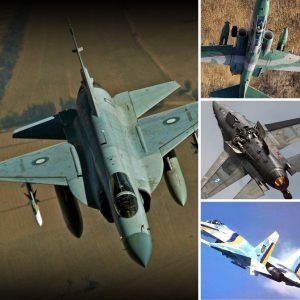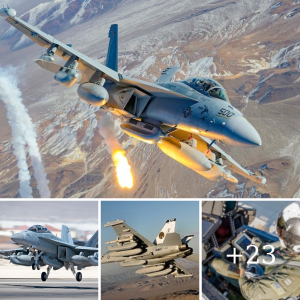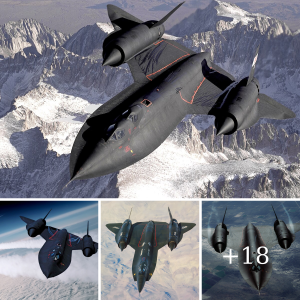The F-14 Tomcat, one of the most iconic and revered fighter jets in military aviation history, became a symbol of American air superiority during the Cold War and beyond. Its unmatched agility, powerful weaponry, and technological innovations allowed it to dominate the skies for over three decades, leaving an indelible mark on aviation enthusiasts and military strategists alike.
A Fighter Born for Superiority
Developed by Grumman for the United States Navy in the early 1970s, the F-14 Tomcat was designed as an all-weather, carrier-capable, supersonic fighter aircraft. It became operational in 1974, replacing the aging F-4 Phantom II as the Navy’s premier air superiority fighter. The Tomcat’s primary role was to defend naval fleets by engaging enemy aircraft at long distances, particularly in the defense of aircraft carriers.
At the heart of the Tomcat’s mission was its advanced radar and missile systems, which allowed it to detect and destroy enemy aircraft from beyond visual range. Its AIM-54 Phoenix missile, combined with the AN/AWG-9 radar, was a game-changer, capable of tracking and engaging up to six targets simultaneously at distances of over 100 miles—making it one of the most lethal fighter jets of its time.
Unrivaled Agility with Variable Geometry Wings
One of the defining features of the F-14 Tomcat was its variable geometry wings. These wings could sweep forward for low-speed maneuvers, offering increased lift and stability during takeoff and landing, or sweep back to reduce drag at high speeds, allowing the Tomcat to hit Mach 2.34 (over 1,500 mph). This unique capability gave the F-14 superior agility in dogfights, while still enabling high-speed intercept missions.
The aircraft’s two Pratt & Whitney TF30 engines also provided impressive power and speed, further cementing its status as a top-tier fighter.
The F-14 in Combat: A Legacy of Power
The F-14 Tomcat saw extensive use throughout its service life, notably during the Cold War, where it patrolled the skies in defense of U.S. Navy carrier strike groups. It participated in high-profile operations such as Operation Desert Storm, enforcing no-fly zones over Iraq, and maintaining air superiority over the Persian Gulf.
Perhaps its most famous engagement occurred in 1981 when two F-14 Tomcats shot down two Libyan Su-22 fighters in a dramatic dogfight over the Gulf of Sidra, solidifying the Tomcat’s reputation as a formidable opponent in aerial combat.
While the Tomcat was most associated with the U.S. Navy, it also played a critical role in the Iranian Air Force, which received F-14s in the 1970s. Despite sanctions and aging technology, Iran continued to operate the F-14 well into the 21st century, highlighting the aircraft’s durability and advanced design.
Cultural Icon: The F-14 in ‘Top Gun’
No discussion of the F-14 Tomcat would be complete without mentioning its starring role in the 1986 blockbuster movie Top Gun. The film, which featured Tom Cruise as Navy pilot Pete “Maverick” Mitchell, immortalized the F-14 as a symbol of American military might and sparked a surge of interest in naval aviation. The breathtaking aerial combat scenes, featuring real F-14 Tomcats, captured the imagination of millions of viewers worldwide, making the Tomcat a pop culture phenomenon.
Even today, the F-14 remains an enduring symbol of cool, thanks to the film’s lasting impact, especially after the release of Top Gun: Maverick in 2022, which paid homage to the legendary fighter jet once more.
The End of an Era: Retirement of the F-14
Despite its storied career, the F-14 Tomcat was eventually retired from U.S. Navy service in 2006, replaced by the more advanced F/A-18E/F Super Hornet. The decision to retire the Tomcat was driven by several factors, including the high cost of maintenance and the development of newer, more versatile multi-role aircraft.
However, the retirement of the F-14 marked the end of an era. Pilots who flew the Tomcat described it as an aircraft with “personality”—one that demanded skill and respect but rewarded those who mastered it with unmatched power and capability.
A Timeless Legacy
Even though the F-14 Tomcat is no longer in active service, its legacy endures. As one of the most iconic fighter jets ever built, it remains a beloved aircraft among aviation enthusiasts, and its place in the history of air combat is secure. Museums across the U.S. display retired F-14s, allowing new generations to appreciate the jet’s technological advancements and storied combat record.
In Iran, the F-14 still flies as part of the Iranian Air Force, showcasing the aircraft’s longevity. The F-14’s durability, versatility, and deadly effectiveness made it a key player in U.S. naval operations for over 30 years.
Conclusion: A Legend in the Sky
The F-14 Tomcat is more than just a fighter jet—it’s a symbol of American air superiority, innovation, and strength. Its distinctive design, cutting-edge technology, and rich combat history made it a true legend of the skies. From its iconic wings to its starring role in Top Gun, the Tomcat has left an indelible mark on aviation history, ensuring its place as one of the most celebrated fighter jets of all time.






